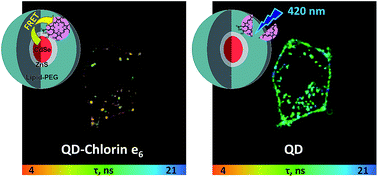A non-covalent complex of quantum dots and chlorin e6: efficient energy transfer and remarkable stability in living cells revealed by FLIM†
Abstract
A Forster resonance energy transfer (FRET) system of semiconductor quantum dots and porphyrins represents a new promising photosensitizing tool for the photodynamic therapy of cancer. In this work, we demonstrate the ability of a non-covalent complex formed between commercial lipid-coated CdSe/ZnS quantum dots (QD) bearing different terminal groups (carboxyl, amine or non-functionalized) and a second-generation photosensitizer, chlorin e6 (Ce6) to enter living HeLa cells with maintained integrity and perform FRET from two-photon excited QD to bound Ce6 molecules. Spectroscopic changes, the highly efficient FRET, observed upon Ce6 binding to QD, and remarkable stability of the QD–Ce6 complex in different media suggest that Ce6 penetrates inside the lipid coating close to the inorganic core of QD. Two-photon fluorescence lifetime imaging microscopy (FLIM) on living HeLa cells revealed that QD–Ce6 complexes localize within the plasma membrane and intracellular compartments and preserve high FRET efficiency (∼50%). The latter was confirmed by recovery of QD emission lifetime after photobleaching of Ce6. The intracellular distribution pattern and FRET efficiency of QD–Ce6 complexes did not depend on the charge of QD terminal groups. Given the non-covalent nature of the complex, its exceptional stability in cellulo can be explained by a combination of hydrophobic interactions and coordination of carboxyl groups of Ce6 with the ZnS shell of QD. These findings suggest a simple route to the preparation of QD-photosensitizer complexes featuring efficient FRET and high stability in cellulo without using time-consuming conjugation protocols.


 Please wait while we load your content...
Please wait while we load your content...